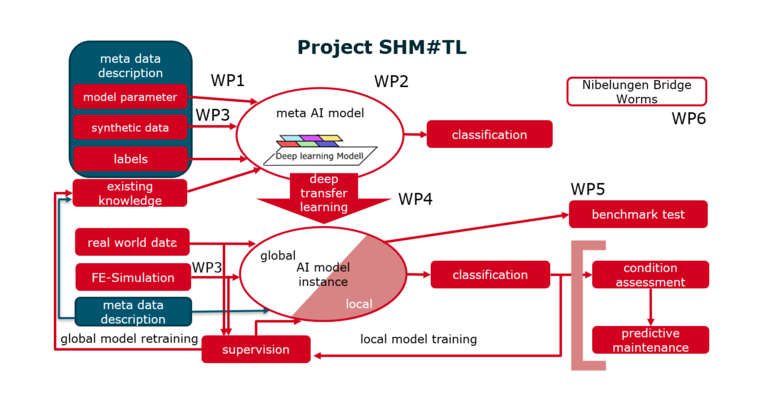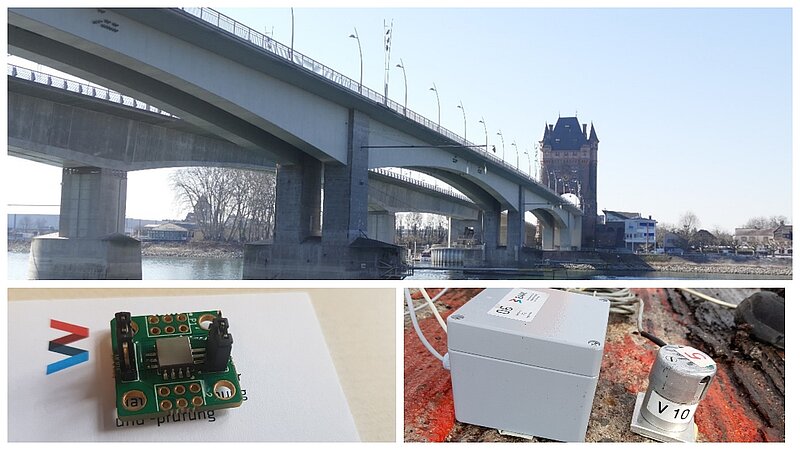Method development and evaluation scheme for cross-life linkage of structural health monitoring data and exiting knowledge via deep transfer learning
In the project "Method development and evaluation scheme for cross-life linkage of structural health monitoring data and exiting knowledge via deep transfer learning", the foundations for a generally valid approach to structural health monitoring (SHM) are being methodically investigated to take into account the degradation of sensors and systems, as well as the only insufficiently identifiable boundary conditions of unique structures through artificial intelligence. This prepares the way for the life-time accompanying linking of condition information and measurement data with a "digital twin" to a predictive maintenance, see Figure 1.
Basic investigations are carried out on AI models learned by means of Deep Transfer Learning. Deep Transfer Learning reuses existing "knowledge" from simulations and real measurements in the form of general AI models to create a suitable AI model with high accuracy using a much-reduced inventory of training data from the individual structure and less training effort. By re-training, new classes, of features not previously known and considered, can be added during the life of the structure to account for sensor effects and structure responses for the particular SHM. The project investigates how perturbations and inaccuracies in the training data affect the knowledge transfer from initial model to sensor model or building model. The finite element method is used to generate general knowledge about a structure.
In the subsequent deep transfer learning process, real world monitoring data are used, which are obtained, from the demonstrator structure, the Nibelungen Bridge crossing the river Rhine near the city Worms, see Figure 2.
The performance is evaluated by means of a benchmark that quantifies the training and interference effort for classification. As a result of the project, it can be evaluated how well prior knowledge about sensor and structural behaviour can be exchanged between AI models between similar types of structures with a comparable monitoring setup.
Milestones in D03:
- Installed a structural health monitoring (SHM) system on the Nibelungen Bridge, equipped with 7 digital sensors to continuously record vibration data.
- Utilized the collected sensor data to develop machine learning models, specifically Convolutional Neural Networks (CNN), for classifying vehicle movements on the bridge.
- Applied transfer learning techniques to reduce the amount of required training data and tested the model's generalization on datasets collected from different sensor locations across the bridge.
Contact
Publications
Peer-Reviewed Journal Paper
Bartels, J.; Xu, R.; Kang, C.; Herrmann, R.; Marx, S.: Experimental Investigation on the Transfer Behaviour and Environmental Influences of Low-Noise Integrated Electronic Piezoelectric Acceleration Sensors. Metrology (2024), 4, 46–65.
Conferences
Herrmann, R., Ramasetti, E., Degener, S., Hille, F., & Baeßler, M. (2024). A living lab for Structural Health Monitoring at the Nibelungen Bridge Worms for Transfer Learning of Structural Dynamics. Proceedings of the 10th European Workshop on Structural Health Monitoring (EWSHM 2024), June 10-13, 2024 in Potsdam, Germany. e-Journal of Nondestructive Testing. https://doi.org/10.58286/29853
Herrmann, R., Hille, F., Pitters, S., Ramasetti, E.,Schneider, R., Wedel, F., Hindersmann, I. (2024): Föderiertes Datenmanagement von Monitoringdaten aus Structural Health Monitoring Anwendungen und daraus gewonnenen Trainingsdaten bei Spannbetonbrücken. 11. Jahrestagung des DAfStb mit 63.Forschungskolloquium der BAM. 16.10. – 17-10.2024, Berlin.
Ramasetti E., Herrmann, R., Degener, S., Baeßler, M. (2024): Development of generic AI models to predict the movement of vehicles on bridges. SMAR 2024 – 7th International Conference on Smart Monitoring, Assessment and Rehabilitation of Civil Structures, 4. - 6. September 2024, Salerno, Italy.
Ramasetti E., Herrmann, R., Degener, S., Baeßler, M. (2025): Investigation of regression models based on deep transfer learning for the effect of bridge temperature on the inclination of a prestressed concrete bridge. SEMC 2025– The 9th International Conference on structural engineering, 1. - 3. September 2025, Capetown, South Africa.
Herrmann, R., Ramasetti, E., Ponnam. P. Degener, S (2025). Charcterization of smart acceleation sensors for traffic recognition using AI at the Nibelungen Bridge Worms. Proceedings of the fib Symposium , June 16-18, 2025, Antibes, France.






